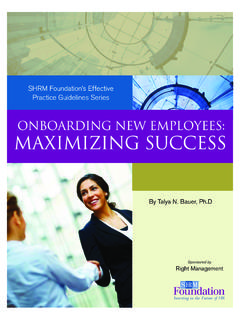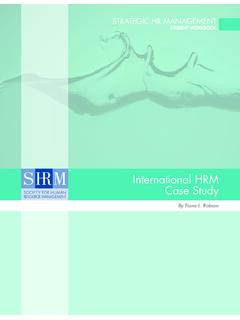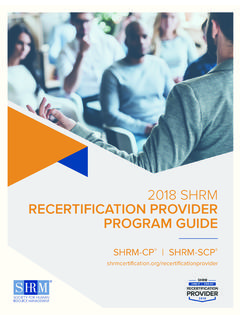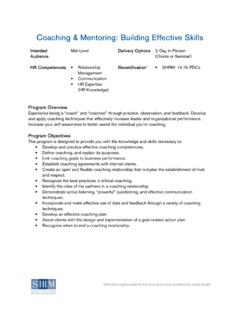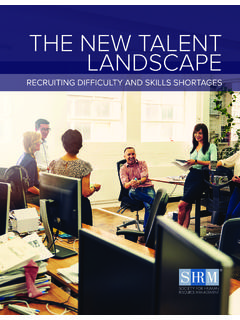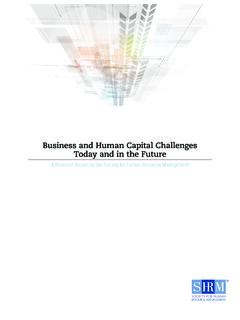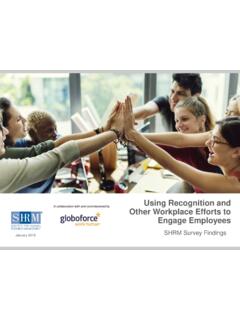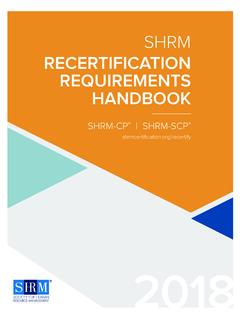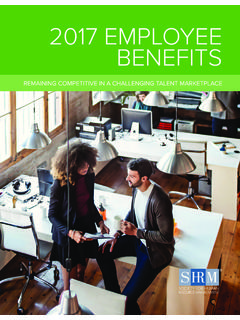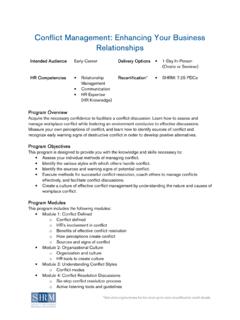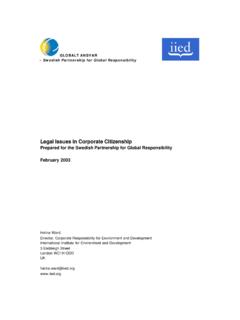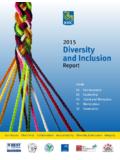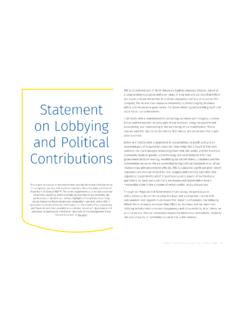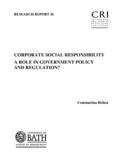Transcription of Role in Corporate Social and Environmental Sustainability
1 EPG. SHRM Foundation's Effective Practice Guidelines Series HRM's Role in Corporate Social and Environmental Sustainability Produced in partnership with the World Federation of People Management Associations (WFPMA) and the North American Human Resource Management Association (NAHRMA). HRM's Role in Corporate Social and Environmental Sustainability This publication is designed to provide accurate and authoritative information regarding the subject matter covered. Neither the publisher nor the author is engaged in rendering legal or other professional service.
2 If legal advice or other expert assistance is required, the services of a competent, licensed professional should be sought. Any federal and state laws discussed in this book are subject to frequent revision and interpretation by amendments or judicial revisions that may significantly affect employer or employee rights and obligations. Readers are encouraged to seek legal counsel regarding specific policies and practices in their organizations. This book is published by the SHRM Foundation, an affiliate of the Society for Human Resource Management (SHRM ).
3 The interpretations, conclusions and recommendations in this book are those of the author and do not necessarily represent those of the SHRM Foundation. 2012 SHRM Foundation. All rights reserved. Printed in the United States of America. This publication may not be reproduced, stored in a retrieval system or transmitted in whole or in part, in any form or by any means, electronic, mechanical, photocopying, recording or otherwise, without the prior written permission of the SHRM Foundation, 1800 Duke Street, Alexandria, VA 22314. Selection of report topics, treatment of issues, interpretation and other editorial decisions for the Effective Practice Guidelines series are handled by SHRM Foundation staff and the report authors.
4 Report sponsors may review the content prior to publication and provide input along with other reviewers; however, the SHRM Foundation retains final editorial control over the reports. Editorial decisions are based solely on the defined scope of the report, the accuracy of the information and the value it will provide to the readers. The SHRM Foundation does not explicitly or by implication endorse or make any representations or warranties of any kind regarding its spon- sors or the products, services or claims made by its sponsors. The SHRM Foundation does not assume any responsibility or liability for the acts, omissions, products or services offered by its sponsors.
5 The Foundation is governed by a volunteer board of directors, comprising distinguished HR academic and practice leaders. Contributions to the SHRM Foundation are tax-deductible. The SHRM Foundation is a 501(c)(3) nonprofit affiliate of the Society for Human Resource Management (SHRM). For more information, contact the SHRM Foundation at (703) 535-6020. Online at 12-0124. Table of Contents iii Foreword v Acknowledgments vii About the Author 1 HRM's Role in Corporate Social and Environmental Sustainability 1 Introduction: The Business Case for Sustainability 3 Supporting Business Sustainability 5 Performing HRM Sustainably 6 The Role of HRM in Sustainability 6 Using the Tools of HRM to Embed Sustainability 8 Sustainable HRM and Its Impact on Sustainability Performance 10 The Roadmap to Sustainable HRM.
6 10 Sustainable HRM, Leadership and Strategy 11 Organizational Readiness for Sustainability 14 Existing Sustainability Frameworks 15 The GRI Framework and HRM-Related Indicators 23 Community Involvement and Employee Volunteering Programs 24 Employer Branding 25 Green HRM. 26 A Possible Sustainability Roadmap and Scorecard 31 The New HR Skills Required for Sustainable HRM. 31 Sustainable HRM in Different Organizational Types 31 Conclusion 33 References 41 Sources and Suggested Readings HRM's Role in Corporate Social and Environmental Sustainability Foreword Dear Colleague: Sustainability is often defined as the ability to meet the needs of the present without compromising the ability of future generations to meet their needs.
7 Going beyond Environmental Sustainability , this concept now includes all types of Social and Environmental impacts. As Sustainability becomes a key focus for more organizations, employers must develop a new way of doing business. In addition to focusing on financial profits, sustainable companies must also consider Social and Environmental impacts when making business decisions. The HR function has a critical role to play. This new SHRM Foundation report, HRM's Role in Corporate Social and Environmental Sustainability , outlines the business case for Sustainability and explains how HRM can take a leading role in both developing and implementing Sustainability strategy.
8 We created the Effective Practice Guidelines series in 2004 for busy HR professionals. By integrating research findings on what works with expert opinion on how to conduct effective HR practice, this series provides the tools needed to successfully implement evidence-based management. This report is the 15th in the series. Other recent reports include Promoting Employee Well- Being, Transforming HR Through Technology and Onboarding New Employees. To ensure the material is research-based, comprehensive and practical, each report is written by a subject-matter expert and then reviewed by both academics and practitioners.
9 The reports also include a Suggested Readings section as a convenient reference tool. All reports are available online for complimentary download at The SHRM Foundation provides unmatched knowledge for the benefit of professional workforce leaders. Our educational resources, such as the Effective Practice Guidelines series, are used in hundreds of college classrooms worldwide. We are also a major funder of relevant, high-impact, original research. We award more than $150,000 annually in education and certification scholarships to SHRM members. And all this good work is made possible by the generous support of donors like you.
10 I encourage you to learn more. Please visit to find out how you can get involved with the SHRM Foundation. Mary A. Gowan, Chair, SHRM Foundation Research Evidence Committee Professor of Management Martha and Spencer Love School of Business Elon University iii HRM's Role in Corporate Social and Environmental Sustainability Acknowledgments The SHRM Foundation is grateful for the assistance of the following individuals in producing this report and the companion executive briefing*: Content Editor Lynn McFarland, Jennifer Schramm President Manager, Workplace Trends and Forecasting Human Capital Solutions, Inc.
